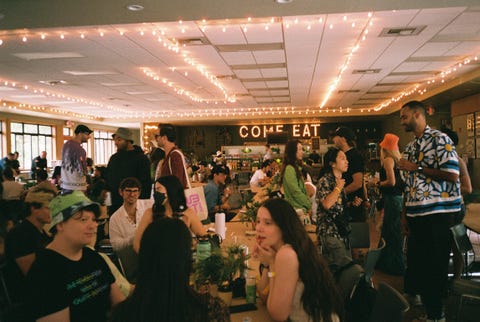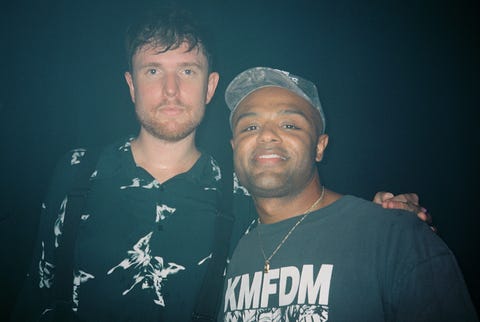On a dry, hot weekend in August, a crowd of several hundred appeared among the pine trees of Idyllwild, a former gold rush town in the San Jacinto Mountains of California. These were members of Friends With Benefits, or FWB for short, a decentralized autonomous organization (DAO) that was taking its online community offline for the first in-real-life gathering of its kind, billed as an “immersive conference and festival experience at the intersection of culture and Web3.” I’m crypto-curious, resistant to anything that requires I spend more time online, but optimistic about its promises of wealth equity and anticipate our collective surrender to its inevitability. I went to FWB Fest to answer some nagging questions: Am I late to the party? Do I want to be at this party?
Skeptics (hi, dad) think cryptocurrency is too risky and speculative. Believers think it’s the currency of the future, and that it has the opportunity to close wealth gaps, empower artists, and change the way we use money, as cryptocurrencies are exchanged without central regulatory authorities like banks or PayPal. Crypto’s fans are also not afraid of the world’s many acronyms. Fest attendees were largely in the latter camp; one described this moment as a “once-in-a-generation opportunity to change money distribution.”
The festival took place at Idyllwild Arts Academy, a private high school on a sprawling campus in the woods. Being white and in my 30s, I appeared to be in the majority, though the population skewed male. Otherwise, I made no attempt to blend in with crypto’s cool kids—I ignored the “bucket hat” bullet on the packing list that we were sent in advance. Many others didn’t. The uniform, as one attendee explained to me, was coded luxury: “Your sunglasses are from a truck stop and your shorts are Old Navy, but then the sneakers are Balenciaga.” On day one, I was deeply off-brand in a pink floral LoveShackFancy dress. I also had the feeling that everyone was on mushrooms without me.
In between performances by artists like Sudan Archives, L’Rain, Kilo Kish, and James Blake, there were hikes, meditation, and foraging. Panelists hosted talks on the future of NFTs (non-fungible tokens) and topics like “How To Eat a Fruit.” Tickets to the all-inclusive weekend cost .5 ETH (shorthand for Ether, the currency on the Ethereum blockchain), or about $927 at the time of writing.
Full membership to the FWB community will cost you 75 FWB tokens. A single token currently trades at $9.33, though it’s been as high as $186. (FWB does offer a “local” membership for 5$FWB, or around $50.) Unlike other DAOs, where entrance requires only buying the token, FWB functions like an internet version of Soho House, requiring both an application approval process and purchase of their currency. As holders of the token, members are incentivized to contribute to projects that raise the token’s value, and they can earn more of it through their participation. After you’ve gotten through the gates, it all goes down in the Discord, the private server where members vote on issues and discuss NFT drops and new projects.
Every DAO serves a different purpose—some raise money for charitable causes, while others offer rewards like first access to NFTs. There are thousands. In 2021, the singularly-minded ConstitutionDAO raised $47 million in ETH to bid on a rare copy of the U.S. Constitution at Sotheby’s. (They lost, and the organization has since disbanded.) FWB is a social DAO, “focused on merging culture and crypto.” Its co-founder is Trevor McFedries, a DJ, music artist, and tech luminary who created the token in 2020 and sent it to his network of friends, granting them access to a private Discord. At first, FWB was essentially a chat room for artists and musicians who were impacted by the pandemic; it’s since grown to 3,000 global members.
A key difference between members-only places like Soho House and a DAO is that “our members vote on expenses every month, our members vote on partnerships every month. Nothing happens without people’s say. Even my salary, if someone had issue with it, they could vote ‘no,’” said Raihan Anwar, one of FWB’s cofounders and their “digital social butterfly.” Like many other FWB members I spoke to, he had an extreme level of enthusiasm for the community. “Our goal was to build the most positive workshop for artists and creatives to explore crypto.”
A few festival attendees brought their dogs and some bought their kids, including a baby named Eeth, after the cryptocurrency. Everyone seemed less interested in the Web3 gold rush (Web3 is the umbrella term for crypto, NFTs, and DAOs) than they did in meeting their Discord friends IRL. McFedries explained a shift towards crypto’s new era: the crowd wasn’t so much Libertarian types but those “interested in creating better economies for creators.” The weekend had at the forefront energy without being smug.
Next to a Menotti’s truck on the festival grounds, where one could get a coffee and a coffee NFT, I sat down with Eileen Skyars, FWB’s head of marketing. “It’s so important for me to be here early and for me to onboard other underrepresented creatives,” she told me. (Skyars is Jamaican and Filipino and identifies as both African American and Asian American). “I’m a first generation immigrant—a lot of our parents didn’t have 401ks. I’ve talked to people here who identified that same way, where they were like, ‘Yeah, I got into crypto for this expansive possibility it has to close wealth gaps.’ On top of that, I think we’re just in a generation that was born into the internet and financial crises—we don’t really believe in 401ks. Why am I going to build forever for this financial future when there may be no future? There are all these questions coming out of the pandemic that make investing in this space look really attractive to young people.”
Although there was plenty of Instagram bait in the swag and scenery that was also attractive to young people, I didn’t see a single arm extended for a selfie, and hardly any bent-neck scrolling. At the music sets I attended in the parachute-covered amphitheater, festival-goers watched not through the screens of their phones but, radically, with their own eyes.
We don’t really believe in 401ks. Why am I going to build forever for this financial future when there may be no future?
In this universe, social currency isn’t earned through Instagram followers or by how closely we can reach the ever-changing beauty standards. Web3’s main platforms are Discord and Twitter, where identities are often shielded by avatars. Expertise, connections, and getting “alpha” info ahead of the curve—that’s the clout this crowd runs on.
But the educational elitism and buy-in comes at the cost of accessibility. “Crypto has an access problem. There’s such a high barrier to entry in terms of understanding half of what is going on,” Makayla Bailey told me in between music sets. Bailey is a 28-year-old Black woman based in New York and a director at Rhizome, a digital arts nonprofit. “I think saying ‘we welcome everybody’ is not enough. You have to do things that address some of the structural issues at hand, like class, race, and diversity.” But of FWB, she said, “It’s one of the more welcoming spaces in Web3 that I’ve experienced so far.”
While Web3 promises for equity and access—the language can at times lean utopian—the same dynamics that exist in corporate spaces exist in these communities, too. The “Social Justice and Web3” event, led by Naaya Wellness founder Sinikiwe Stephanie Dhliwayo, was one of the most dynamic but least attended events I sat in on. At another discussion, held in a classroom and led by three women, one male attendee walked in late, sat at the teacher’s desk, and seemed to speak louder and longer than all three women who were leading the discussion.
Still, there’s progress. At Saturday’s keynote “Dissent by Design,” Nadya Tolokonnikova, a member of the feminist protest art collective Pussy Riot, discussed using Web3 for activism. In response to the war in Ukraine, Nadya’s UnicornDAO raised nearly $7 million in two days with the sale of an NFT of the Ukrainian flag. Without the threat of government interference or the bureaucracy of a traditional non-profit, funds were raised and quickly distributed to Ukrainian citizens. One major donor was the Ukrainian-American owner of OnlyFans, Leonid Ravinsky, who donated $1.3 million. “It showed us the power of Web3. Crypto is useful not just for people pumping their bags, but for public good and for peace,” Nadya said at the panel. And in response to the overturning of Roe v. Wade, UnicornDAO created an abortion fund that provides transportation, lodging, and health services.
Since cryptocurrency can be used without the location tracking of banks or ATMs, it’s been critical to Nadya’s survival. “As an activist in Russia, we needed to use [it] to stay alive.” After Pussy Riot performed an anti-Putin “Punk Prayer” at a Moscow cathedral in 2012, Nadya, along with her fellow members, was jailed for 21 months. She’s considered a “foreign agent” of Russia, and due to her status, she doesn’t share her location in real time.
Later in the evening, she and I sat together on a porch outside the artists’ cabin, behind the twinkle-lit bar serving natural wine from Martha Stoumen and offering cans of the disturbingly-named water Liquid Death. The artist Weyes Blood was playing a set in the amphitheater. I asked Nadya, whose latest Pussy Riot album is titled MATRIARCHY NOW, how to bring more equity into the cryptosphere. “In a lot of cases, when women or any other underrepresented communities are being asked to participate in something, they’re just being used as currency for virtue signaling, and it’s important to make sure that they actually get paid or get tokens for their participation. Make sure to bring real value to people who contribute to your diversity,” she told me.
“Last year only 5 to 10 percent of total NFTs sales were done by female artists, which is terrible,” she said. To shift those stats, UnicornDAO collects art by women-identified and LGBTQIA+ people. Its board members include the musicians Sia and Grimes. “If we keep [this community] exclusive, it’s gonna be just a room of white males sucking their own dicks, which is how most of the parties look these days.”
I considered our psychedelic-forest surroundings; how I hadn’t been at a gathering this large since 2019, or one this specific, ever. Is crypto the future, or is it just a moment in time? I asked Nadya. “I believe it is the future. It brings ownership back to people. On Instagram your account could be deleted at any given second. Even though I provided my content for free, and helped [Instagram] to develop their platform and create generational wealth for Mark Zuckerberg, I can be kicked out at any time. When you join Web3 social media platforms, you own your piece, you own your properties. You own a piece of land in that social media system.”
Another accessibility issue is the time commitment that understanding and keeping up with a constantly-evolving ecosystem demands. The always-open market breeds a culture of FOMO. On Sunday, a conversation on mental health was led by Yana Sosnovskaya of Zora, where artists expressed the anxiety of seeing their NFT prices fluctuate, and others shared the pressure they felt to have all the right expertise and language in the Discord. A great way to deal with the ups and downs of crypto and Web3, one attendee said, was “to have friends who don’t know what crypto and Web3 is.”
Despite the anxieties, there was a hopeful and quietly rebellious energy to the weekend, perhaps not unlike the gold prospectors who rushed the region in the 1860s, most of whom came up empty-handed. These Friends With Benefits seemed happy simply to find relief from pandemic loneliness and a place to channel millennial disillusionment. That’s a party I can get behind. Whether or not it yields gold feels beside the point.
Hannah Summerhill is the co-host of the Kinswomen Podcast. Her book with Yseult Polfliet Mukantabana, Real Friends Talk About Race, comes out April 2023.



